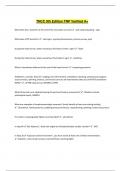TNCC 9th Edition TNP Verified A+
What does the J stand for at the end of the secondary survery? ✔️just keep evaluating - vipp
What does VIPP stand for? ✔️vital signs, injuries/interventions, primary survey, pain
During the head-to-toe, where would you find Grey-Turner's sign? ✔️flank
During the head-to-toe, where would you find Cullen's sign? ✔️umbilicus
What is sometimes deferred at the end of the head-to-toe? ✔️inspecting posterior
Antibiotics, consults, head CT, imaging, law enforcement, mandatory reporting, psychosocial support,
social services, splinting, tetanus, and wound care are all interventions that you do AFTER and before
WHAT? ✔️AFTER head-to-toe, BEFORE J (VIPP)
What three items are obtained during the pertinent history assessment? ✔️Medical records,
prehospital report, SAMPLE
What are examples of nonpharmacologic measures? (must identify at least one during testing)
✔️Distraction, family presence, padding bony prominences, repositioning, splinting, verbal reassurance
For whom is capnography highly recommended? ✔️all patients
In step M of "Get Adjuncts", what else might be indicated besides cardiac monitor? ✔️EKG
In Step 16 of "Exposure and Environment", you must name at least one of these interventions:
✔️blankets, room temp increase, warmed fluids, warming lights
,At what point PRIOR TO the head-to-toe is the patient inspected for obvious injuries? ✔️In Step 15 of
"Exposure and Environment"
In Step 13 of "Disability", what is assessed if pt is altered? ✔️glucose
To assess circulation, you must do these two main tasks: ✔️1. inspect AND palpate skin color, temp,
moisture and 2. palpate a pulse
What do you do when alterations are identified in any of the steps in the primary survery? ✔️intervene
as appropriate and reassess
What three assessments must be done if the patient is intubated? ✔️1. attach CO2 detector and assess
for evidence of exhaled CO2; 2. observe for rise and fall of the chest w/ assisted ventilations; 3.
auscultate over epigastrium for gurgling AND lungs for bilateral breath sounds
Four of these must be identified to assess breathing effectiveness: ✔️Breath sounds,
depth/pattern/rate, spontaneous breathing, subcutaneous emphysema, increased work of breathing,
symmetrical chest rise and fall, tracheal deviation/JVD, open wounds/deformities, skin color
What can be applied in step 12 of "Circulation and Control of Hemorrhage" for which credit is given in
the LMNOP section? ✔️cardiac monitor
When should 2 IV sites be established? ✔️During "Circulation" assessment
If the patient is intubated and you've already assessed ETT placement, what else needs to be done with
the ETT? (step 10) ✔️assess ETT position by noting the number at teeth/gums AND secure ETT
What should you verbalize after completing all ETT assessments? ✔️moving patient from assisted
ventilation to mechanical
During which part of the primary survey would you anticipate the need for a chest tube, intubation,
decompression of pneumothorax, oxygen, or BVMs? ✔️"Breathing and Ventilation"
, Four of these must be identified to assess patency and protection of the airway: ✔️bony deformity,
loose teeth, edema, inhalation injury, sounds, tongue obstruction, burns, fluids, foreign objects,
vocalization
During which part of the primary survey would there be anticipation for intubation, insertion of
OPA/NPA, removal of any loose teeth or foreign objects, or suctioning? ✔️Assessing patency and
protection of the airway, Step 7 of
"Alertness and Airway with Simultaneous Cervical Spinal Stabilization"
If c-spine stabilization is necessary, what need should be stated? ✔️the need for a second person to
provide manual c-spine stabilization
An adult patient who sustained a severe head trauma has been intubated and is being manually
ventilated via a bag-mask device at a rate of 18 breaths/minute. The patient has received one
intravenous fluid bolus of 500 mL of warmed isotonic crystalloid solution. The PaCO2 is 30 mm Hg (4.0
kPa), and the pulse oximetry is 92%. BP is 142/70 mm Hg. What is the most important intervention to
manage the cerebral blood flow?
A.Decrease the rate of manual ventilation.
B.Initiate another fluid bolus.
C.Re ✔️A.Decrease the rate of manual ventilation.
An older adult presents to the emergency department with complaints of dizziness, headache, and
nausea. The patient was involved in a motor vehicle collision 10 days ago. There was no loss of
consciousness and a hematoma is noted to the forehead. The patient is currently on anticoagulant
therapy. What is most likely the cause of their symptoms?
A.Intracerebral hemorrhage
B.Epidural hematoma
C.Diffuse axonal injury
D.Post-concussive syndrome ✔️post-concussive syndrome




